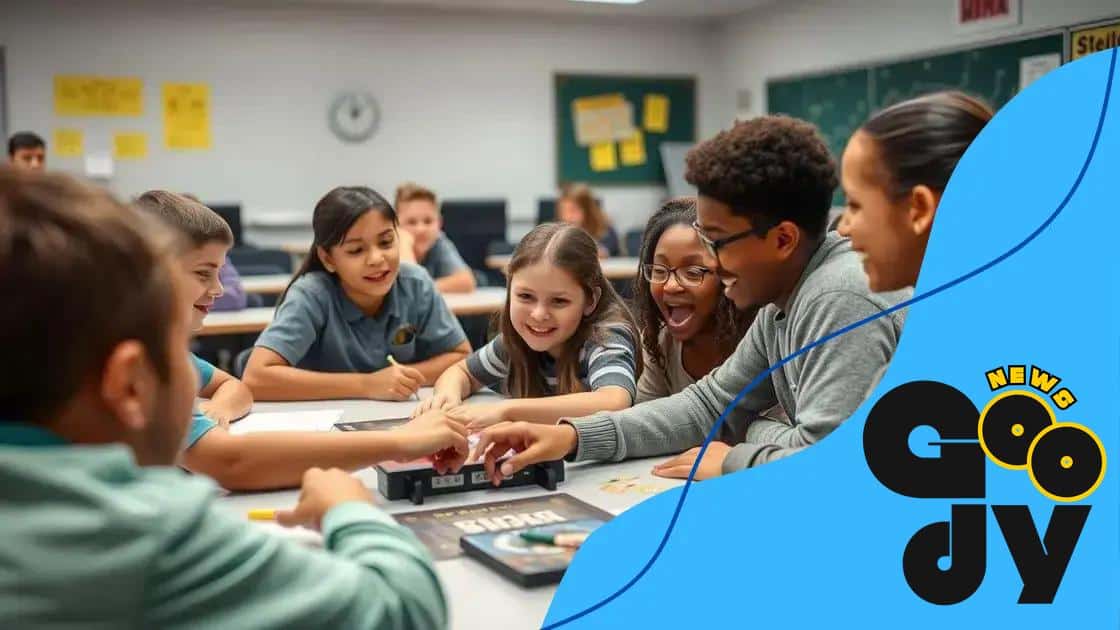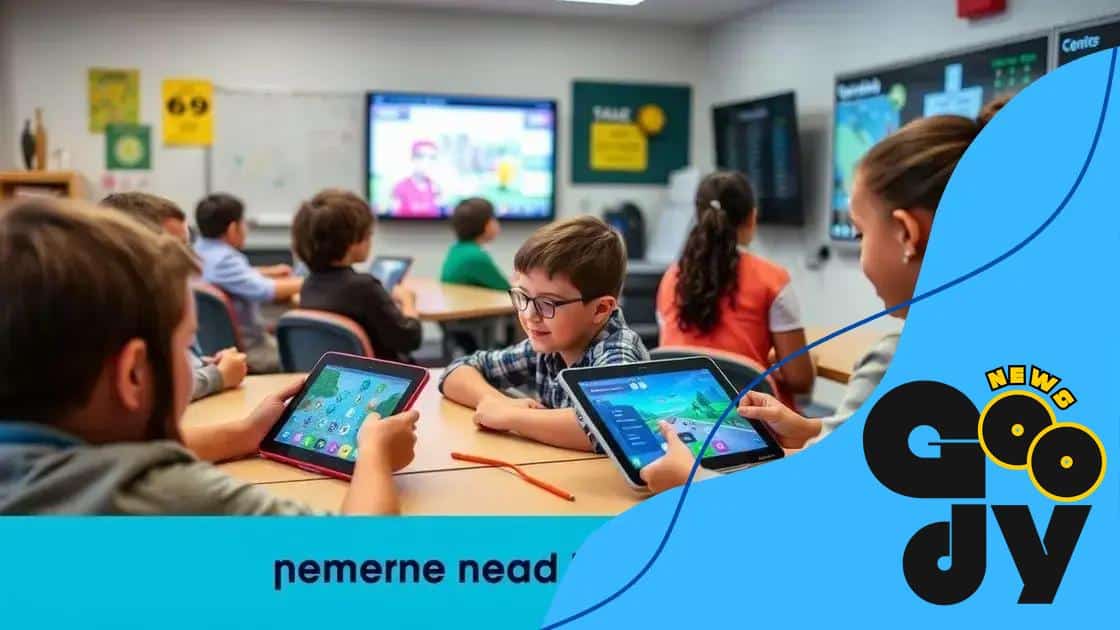Gamification in K-12 education: engaging students effectively

Gamification in K-12 education integrates game elements into learning, enhancing student engagement, promoting collaboration, and developing critical skills while leveraging technologies like AI and VR for personalized experiences.
Gamification in K-12 education is reshaping the way students engage with learning. Imagine your child excited to study, motivated by game-like experiences! This article explores how gamification can spark that enthusiasm in the classroom.
Understanding gamification and its principles
Understanding gamification starts with recognizing its core principles. It involves incorporating game design elements into non-game contexts. This approach is particularly effective in K-12 education, as it enhances student engagement and motivation.
One key element of gamification is reward systems. When students receive points, badges, or leveling up in games, they feel a sense of accomplishment. This can translate into the classroom through reward systems that recognize student achievements.
Major Principles of Gamification
Another essential principle is competition. Gamification can foster healthy competition among students, pushing them to perform better. This can be achieved through leaderboards or team challenges where students work together towards common goals.
- Game mechanics enhance participation and focus.
- Immediate feedback helps in tracking progress.
- Storytelling makes lessons more relatable.
- Interactive elements create a dynamic learning environment.
In addition to competition, the principle of progression is vital. Progression in games is usually clear and motivating. In classes, clear objectives and a roadmap can help students visualize their learning journey. With these principles combined, gamification can make lessons lively and captivating.
Lastly, social interaction is a crucial aspect. Gamification encourages students to collaborate and communicate with each other. Building a sense of community can lead to a more supportive atmosphere, making learning more enjoyable and less isolating. Thus, through understanding these principles of gamification, educators can create a vibrant classroom experience.
Benefits of gamification in K-12 classrooms
Incorporating gamification in K-12 classrooms brings a wealth of benefits that enrich the learning experience. One of the most significant advantages is increased student engagement. When students are actively involved in learning through games, they are more likely to participate and retain information better.
Another benefit of gamification is the development of essential skills. Students learn to work collaboratively in teams, solve problems creatively, and think critically in competitive environments. These skills are invaluable as they prepare for future challenges.
Motivation and Learning
Gamification also helps in boosting motivation. Traditional education methods can sometimes be monotonous, but game elements like points, badges, and live leaderboards create excitement in the classroom. Students are driven to achieve goals, making learning more dynamic and enjoyable.
- Creates a fun learning atmosphere.
- Encourages self-directed learning.
- Fosters healthy competition.
- Provides instant feedback on progress.
Additionally, gamification meets diverse learning styles. Some students may thrive on visual aids, while others respond better to hands-on activities. With gamified learning, students can engage with content in various ways, ensuring everyone can succeed.
Moreover, gamification can significantly enhance academic performance. Research has shown that students exposed to gamified environments often outperform their peers in standard learning conditions. This improvement is a testament to engaging and challenging educational experiences.
In summary, the benefits of gamification in K-12 classrooms extend beyond merely making learning fun. It cultivates skills, enhances motivation, caters to different learning styles, and ultimately leads to better academic outcomes.
Successful examples of gamification in education

There are many successful examples of gamification in education that illustrate its effectiveness in engaging students. Schools around the world have adopted game mechanics to enhance learning experiences and achieve impressive results.
One well-known example is the use of Classcraft, a game that turns classrooms into adventures. Students create characters and earn experience points by participating in class activities, completing homework, and collaborating with peers. This approach fosters teamwork and makes learning enjoyable.
Existing Case Studies
Another notable success comes from the Kahoot! platform, where teachers create quizzes that students participate in real-time. This interactive format not only promotes competition but also encourages participation and retention of information. Students eagerly look forward to these sessions, often leading to improved understanding of classroom material.
- Prodigy Math enhances math skills by turning practice into an engaging RPG-style adventure.
- Duolingo makes language learning fun with levels, rewards, and competitive elements.
- DreamBox adapts math lessons to student needs through gamified learning.
- Quizizz provides a game-like atmosphere for students to learn through quizzes and instant feedback.
Schools using these gamified tools report higher student motivation and academic improvement. Gamification allows educators to personalize learning experiences, tailoring them to meet diverse learner needs. This results in students feeling more in control of their learning, making them active participants rather than passive recipients of information.
Moreover, these platforms incorporate analytics that help teachers track progress and address individual student challenges. This feedback loop is vital to promote continuous improvement and adaptation in teaching methods.
Challenges of implementing gamification
While gamification offers many benefits in education, there are several challenges in its implementation that educators must face. Understanding these obstacles is crucial for successful integration into the classroom to enhance student learning.
One major challenge is the initial resistance from educators. Many teachers may be unfamiliar with gamification concepts and question their effectiveness. Providing proper training and resources can help overcome this barrier.
Key Challenges in Implementation
Another concern is the potential for uneven student engagement. Not every student responds to game mechanics the same way. Some may find it motivating, while others might feel overwhelmed by the competition. It’s essential to balance competitive elements with collaboration to promote a positive learning environment.
- Resource allocation is necessary for proper technology and tools.
- Balancing traditional methods with gamified approaches can be difficult.
- Teacher workloads may increase when designing gamified activities.
- Aligning games with curriculum standards is essential for effectiveness.
Additionally, there are challenges regarding accessibility. Not all students have equal access to the technology required for gamified learning. Educators need to ensure that all students can participate, and this may mean providing additional resources to those who need them.
Implementing gamification also requires continuous assessment and feedback. Teachers must monitor student progress and adapt methods based on their responses. This ongoing evaluation is necessary to ensure that gamification is meeting educational goals.
Future trends in gamification for learning
The future of gamification for learning looks bright as technology evolves and educational approaches adapt. Innovations are emerging that can enhance student engagement and motivation even further.
One exciting trend is the use of virtual reality (VR) and augmented reality (AR) in gamified lessons. These technologies offer immersive experiences that allow students to explore and interact with subjects like never before. Imagine studying history by virtually walking through ancient cities or biology by exploring the human body in 3D.
Emerging Technologies and Their Impact
Another trend is the integration of artificial intelligence (AI) into gamification. AI can tailor learning experiences to each student’s needs, providing personalized challenges and feedback. This individualized approach helps students progress at their own pace, making learning more effective.
- Adaptive learning paths based on student performance and preferences.
- Analytics that provide insights into student progress and engagement.
- Community-based gaming where learners collaborate across distances.
- Gamification in professional development and lifelong learning.
Social elements are also set to grow. Future gamification approaches will likely incorporate more collaborative features, such as team challenges that encourage peer learning. When students work together to achieve goals, they not only learn academic content but also essential social skills.
Additionally, with the rise of eSports and gaming culture, educational institutions may leverage these interests to create engaging learning experiences. By connecting classroom content to students’ passions, educators can inspire greater enthusiasm for learning.
FAQ – Frequently Asked Questions about Gamification in K-12 Education
What is gamification in education?
Gamification in education involves incorporating game elements, such as points and rewards, into learning activities to increase student engagement and motivation.
How can gamification benefit students?
Gamification can enhance student motivation, foster collaboration, and develop essential skills like problem-solving and critical thinking.
What are some examples of gamification in the classroom?
Examples include using platforms like Classcraft for role-playing games, Kahoot! for interactive quizzes, and Prodigy Math for game-based math practice.
What challenges do educators face when implementing gamification?
Challenges include initial resistance from teachers, ensuring equal access to technology, and balancing game mechanics with traditional teaching methods.





